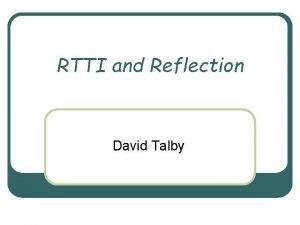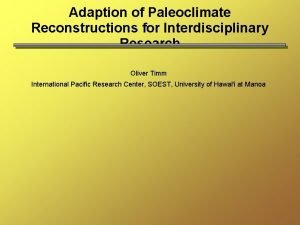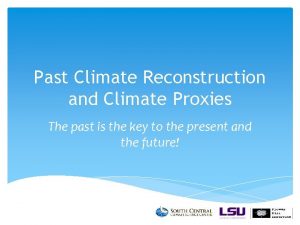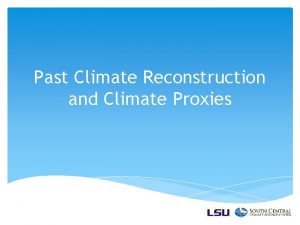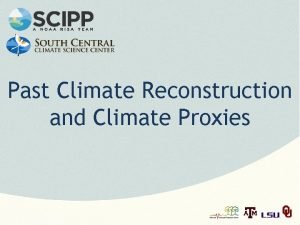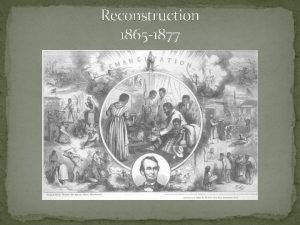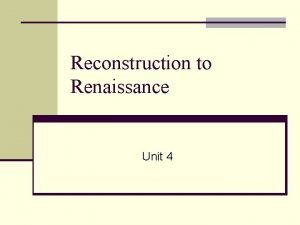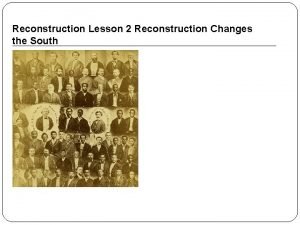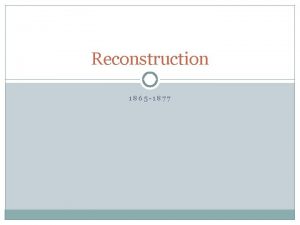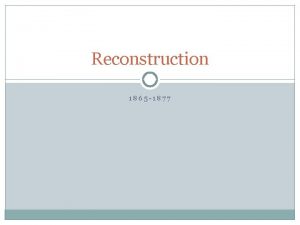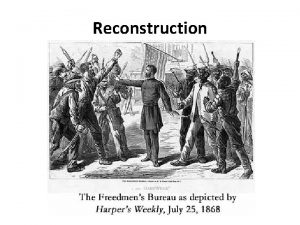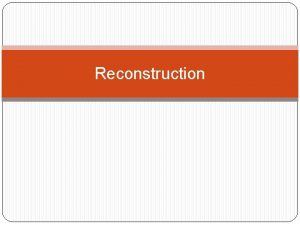Past Climate Reconstruction and Climate Proxies The past































- Slides: 31

Past Climate Reconstruction and Climate Proxies The past is the key to the present and the future!

2 Error bars for proxy data Paleoclimate Records Instrumental Records

The Instrumental Record The earliest records of temperature measured by thermometers are from western Europe in the late 17 th century and by the early 20 th century records were being collected in almost all regions. Records from polar regions began in the 1940 s. The National Climatic Data Center maintains a collection of temperature records from over 7, 000 stations worldwide, about 1, 000 go back to the 19 th century. Temperature observations the first 2 weeks of July 1776 in Thomas Jefferson’s Weather Memorandum Book

Satellite-Derived Temperature Record Satellite measurements have been used to construct globally complete land oceanic temperatures since 1979. Provides a spatially uniform perspective whereas weather observations are biased towards where people are located. Allows for measurements over hard-to-sample areas like the oceans and ice sheets. Source: NOAA

Historical Records Historical documents contain past weather and climate information. Ship logs are particularly useful for accounts of sea ice, storms, and hurricanes. Farmers’ logs can include useful information such as planting or harvest dates and overall crop health. Personal diaries are another resource.

Paleoclimatology is the study of past climate that does not use instrumental observations but proxies from the environment. Proxies of climate variability are recorded in the rings of trees, coral colonies, ice sheets and glaciers, cave deposits, layers of sediments (pollen, microfossils, and organics) and more. These natural recorders of climate contain a chronology or way to tell time and they record changes in environment, driven by climate.

Annual Banding Ice cores Varve sediments Tree rings Corals Count years Absolute age if date of collection is known GISP 2 National Ice Core Laboratory USGS Varves of Lehmilampi lake (Eastern Finland), light layer = spring flood mineral layer, dark layer=organic summer -winter layer

Tree Rings 8

9

Tree Ring Record Cross dating of tree rings can provide exact date matches between trees with different ages or from different locations. Major events such as fire, flood, avalanche, drought, and insect infestation can all be evident. The regular year to year variations in rings provide indications of past temperature, precipitation and streamflow. Using petrified or fossilized wood, tree ring records go back more than 10, 000 years in some locations. Source: NOAA

Dendrochronology Master chronology Many trees from a region are cross-dated Locally absent years False rings Quality Checked COFECHA 11

El Malpais Tree-Rings Lava fields are an isolated and harsh environment with good wood preservation Tree locations Grissino-Mayer, 2000 New Mexico region is precipitation sensitive Ring width varies with annual precipitation

El Malpais Tree-Ring Record Average tree age = 391 years, 76 trees > 500 years Oldest living tree found is a 1274 -year old Douglas-fir. De. Long et al. , 2009 and Grissino-Mayer 1996

El Malpais Tree-Ring Record https: //www. ncdc. noaa. gov/paleo/droug ht/drght_grissno. html

Corals as Climate Archives 15

Corals A coral is a colony composed of hundreds of thousands of tiny animals called coral polyps. Coral polyp deposits calcium carbonate, which forms the coral skeleton, and many corals form the coral reef. Within the coral skeleton are density bands, similar to tree rings and chemistry with the Skeletal depends on temperature and other environmental conditions. USGS De. Long A long core of a coral skeleton can cover hundreds of years and exact dates can be determined based on counting the growth bands or U-Th dating. Coral records help us understand the tropical climate system, which is a strong driver of global climate.

Coral SST Reconstruction De. Long et al. , 2014 17

Ice Core Records The Greenland ice sheet is nearly two miles thick and provides climate history going back 200, 000 years. Parts of the Antarctic ice sheet are even thicker, going back over 700, 000 years. Layers of dust present in ice cores from past windy seasons or could represent past volcanic eruptions. Tiny fossil air bubbles are even trapped in the ice, time capsules of past air.

High Latitude Ice Records Most ice cores have been retrieved from high latitude sites in Greenland (GISP, GISP 2, GRIP) and Antarctica (Taylor Dome, Siple Dome, Vostok) 19

Ice Core Records Temperature change for the past 150, 000 years from an Antarctic ice core.

Vostok Antarctica Ice Core Record Petit et al. , 1999 21

Sediments 22

Sediment Records Sediment cores from closed basin lakes in the Yucatan Peninsula indicate evidence of an intense period of drought that coincides with the collapse of the Classic Mayan Civilization. An archaeological mystery, southern Mayan cities were abandoned between 800 and 900 AD.

Ocean Drilling 24

Marine Sediments

Multi-beam image of the ancient cypress forest site off the coast of Alabama. Vertical relief is not to scale. 26


Figure 2. Bald cypress sample with ring width measurements. This sample (ID: GOM 100) was included in the tree-ring chronology from the main study site (Figure 3). Full sample image is shown (left) with a zoomed inset displayed with the width measurement path (right). 28

Pollen Tupelo (Nyssa aquatica) Pine (Pinus spp. 29 Bald Cypress Taxodium distichum

Other Proxy Records The geologic, fossil and sediment record also provide indications of Earth’s past climate. Pollen grains are especially well preserved in sediment layers, like at the bottom of a lake or ocean.

Questions and Discussion
 Java reflection api
Java reflection api Palmyra soest
Palmyra soest Climate reconstruction
Climate reconstruction Climate change 2014 mitigation of climate change
Climate change 2014 mitigation of climate change Past perfect with simple past
Past perfect with simple past Past simple continuous and perfect
Past simple continuous and perfect Hình ảnh bộ gõ cơ thể búng tay
Hình ảnh bộ gõ cơ thể búng tay Ng-html
Ng-html Bổ thể
Bổ thể Tỉ lệ cơ thể trẻ em
Tỉ lệ cơ thể trẻ em Voi kéo gỗ như thế nào
Voi kéo gỗ như thế nào Glasgow thang điểm
Glasgow thang điểm Hát lên người ơi
Hát lên người ơi Các môn thể thao bắt đầu bằng tiếng đua
Các môn thể thao bắt đầu bằng tiếng đua Thế nào là hệ số cao nhất
Thế nào là hệ số cao nhất Các châu lục và đại dương trên thế giới
Các châu lục và đại dương trên thế giới Công thức tính độ biến thiên đông lượng
Công thức tính độ biến thiên đông lượng Trời xanh đây là của chúng ta thể thơ
Trời xanh đây là của chúng ta thể thơ Cách giải mật thư tọa độ
Cách giải mật thư tọa độ Phép trừ bù
Phép trừ bù Phản ứng thế ankan
Phản ứng thế ankan Các châu lục và đại dương trên thế giới
Các châu lục và đại dương trên thế giới Thể thơ truyền thống
Thể thơ truyền thống Quá trình desamine hóa có thể tạo ra
Quá trình desamine hóa có thể tạo ra Một số thể thơ truyền thống
Một số thể thơ truyền thống Cái miệng bé xinh thế chỉ nói điều hay thôi
Cái miệng bé xinh thế chỉ nói điều hay thôi Vẽ hình chiếu vuông góc của vật thể sau
Vẽ hình chiếu vuông góc của vật thể sau Biện pháp chống mỏi cơ
Biện pháp chống mỏi cơ đặc điểm cơ thể của người tối cổ
đặc điểm cơ thể của người tối cổ Thứ tự các dấu thăng giáng ở hóa biểu
Thứ tự các dấu thăng giáng ở hóa biểu Vẽ hình chiếu đứng bằng cạnh của vật thể
Vẽ hình chiếu đứng bằng cạnh của vật thể Fecboak
Fecboak
